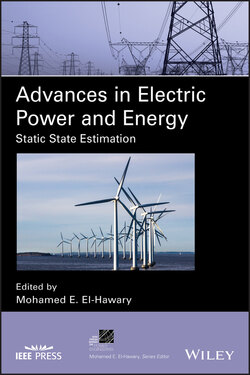Читать книгу Advances in Electric Power and Energy - Группа авторов - Страница 38
2.2 FORMULATION
ОглавлениеThe traditional weighted least of squares (WLS) state estimation problem has the form
(2.1)
subject to
(2.2)
(2.3)
where x is the n × 1 state variable vector, J(x) the objective function (weighted quadratic error), h (x) a m × 1 functional vector expressing the measurements as a function of the state variables, w a m × 1 weighting factor vector, z the m × 1 measurement vector, f ( x ) the p × 1 equality constraint vector mainly enforcing conditions at transit buses (no generation and no demand), and g (x ) the q × 1 inequality constraint vector enforcing physical limits of the system.
Among the components of vector h (x ), note that active and reactive and power injections at bus i are computed as
(2.4)
(2.5)
where Pi and Qi are the active and reactive power injection at bus i, respectively; vi and θi are the voltage magnitude and angle at bus i, respectively; Gij and Bij are the real and imaginary part of the bus admittance matrix, respectively; and Ξ is the set of all buses. Gii and Bii can be computed as indicated in [7].
The active and reactive power flow ij are computed as
(2.6)
(2.7)
where Pij and Qij are the active and reactive power flow from bus i to bus j, respectively, and the shunt susceptance of line ij.
As it is customary, measurements are considered to be independent Gaussian‐distributed random variables.
